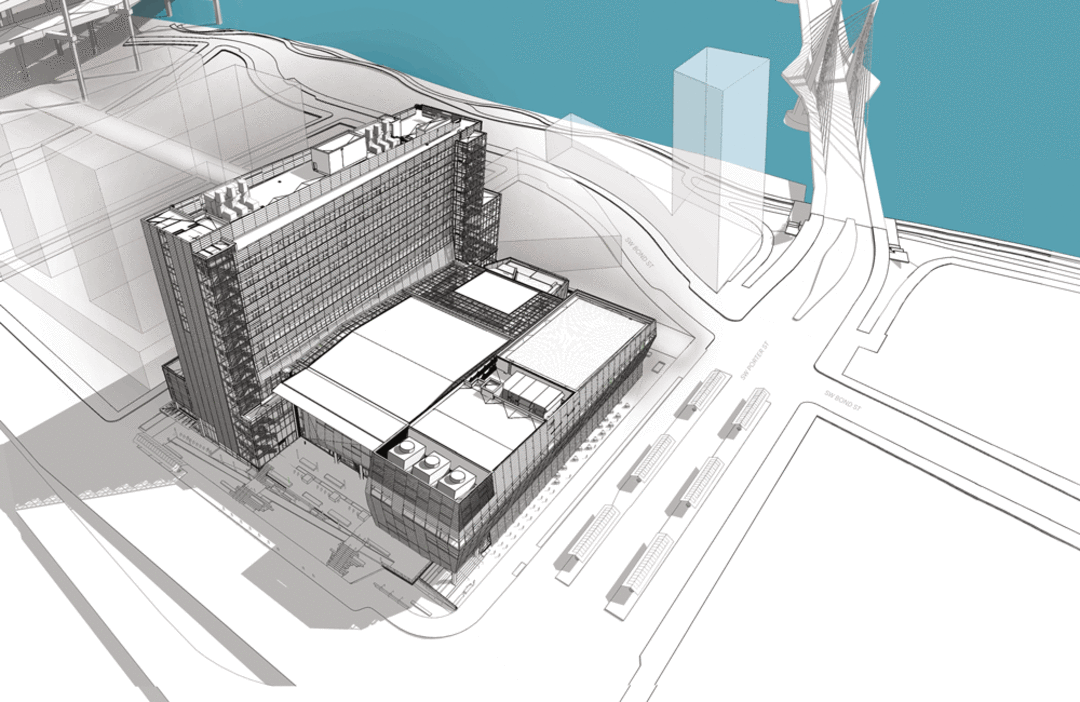The South Waterfront's New Research Epicenter

Image: Courtesy Sera
With more than 500,000 square feet of labs and classrooms (and a $295 million price tag) the Collaborative Life Sciences Building became the largest educational building ever constructed in Oregon when it opened this summer. And with its strategic location next to South Waterfront’s new Tilikum Crossing, the research center will anchor a web of urban connections—and, its builders hope, lure talent and money to Portland’s burgeoning research sector.
- The CLSB brings together medicine, dentistry, pharmacy, chemistry, and biology programs from Oregon Health & Science University, Oregon State University, and Portland State University. The stout Skourtes Tower houses 130,000 square feet of research labs. The south building contains offices and medical simulation labs. In between are two “pods” of lecture halls.
-
To meet differing structural demands of labs, classrooms, and lecture halls, Los Angeles–based CO Architects (teamed with locals Sera) broke CLSB into three discrete structures connected by an atrium. Thick, rubber diaphragms between the components keep rain out while allowing the structures to move separately in an earthquake.
-
Four floors of the Skourtes Tower will be filled with new OHSU School of Dentistry facilities, with 76 dummies, complete with simulated spit, for students to practice on. The school’s discounted dental services will now come with city and river views.
- The building will now house Portland State’s largest lecture hall. PSU will hold 113 classes and labs per year here. OHSU and PSU faculty teams will collaborate on research. OHSU already draws more students from PSU and OSU than any other schools; the hope is to foster even more through close contacts between the institutions.
-
The five electron microscopes (typical price tag: $8 million) in OHSU’s Center for Spatial Systems Biomedicine can detect early signs of cancer at a submolecular level. They are also sensitive to vibration of passing light-rail trains, traffic on the Marquam and Ross Island Bridges, and even the subsurface roar of the Willamette. The new facility is located beneath the campus promenade, set on a 74-by-54-by-4-foot concrete slab atop 100-foot pilings, surrounded by a moat of air, allowing the scopes to transmit blur-free pictures.
-

Anyone can enter the CLSB’s soaring atrium, designed, says Brian Newman, OHSU’s director of campus development, to put “research on display.” Windows open onto the labs, bathing them in the atrium’s natural light and allowing curious passerby—1,600 students visiting each day, plus grade-schoolers crossing the car-free bridge from OMSI, and the general public—to watch researchers in action. Eleven ramps, some with seating, fly overhead, connecting the building’s diverse activities.
-
With the planned opening of Tilikum Crossing in September 2015, light-rail trains, streetcars, and buses will stop at the building more than 1,000 times a day. Travel time from OHSU to PSU will be five minutes; to OMSI, one minute.
- OHSU and the adjacent property owners, the Zidell family, raised the grade of the entire area 14–20 feet to satisfy flood regulations and build underground parking. The higher ground also allowed Tilikum Crossing to descend from its 77.5-foot peak in a gentle, ADA-compliant slope. Beneath the west bridgehead are three steel casings up to 60 inches in diameter to deliver the hot and and chilled water of a potential future district-wide energy system.
-
As the new, riverside Schnitzer Campus takes shape, a central promenade will parallel SW Bond Street. Should OHSU match Phil and Penny Knight’s pledge of $500 million for cancer research, two more buildings—1 million square feet—will begin rising in 2016, a massive expansion of clinical trials and outpatient facilities.




